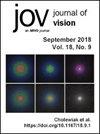Visual event boundaries trigger forgetting despite active maintenance in visual working memory.
IF 2.3
4区 心理学
Q2 OPHTHALMOLOGY
引用次数: 0
Abstract
The contents of visual perception are inherently dynamic-just as we experience objects in space, so too events in time. The boundaries between these events have downstream consequences. For example, memory for incidentally encountered items is impaired when walking through a doorway, perhaps because event boundaries serve as cues to clear obsolete information from previous events. Although this kind of "memory flushing" can be adaptive, work on visual working memory (VWM) has focused on the opposite function of active maintenance in the face of distraction. How do these two cognitive operations interact? In this study, observers watched animations in which they walked through three-dimensionally rendered rooms with picture frames on the walls. Within the frames, observers either saw images that they had to remember ("encoding") or recalled images they had seen in the immediately preceding frame ("test"). Half of the time, a doorway was crossed during the delay between encoding and test. Across experiments, there was a consistent memory decrement for the first image encoded in the doorway compared to the no-doorway condition while equating time elapsed, distance traveled, and distractibility of the doorway. This decrement despite top-down VWM efforts highlights the power of event boundaries to structure what and when we forget.尽管视觉工作记忆中存在着积极的维护,但视觉事件边界仍会引发遗忘。
视觉感知的内容本质上是动态的--就像我们体验空间中的物体一样,时间中的事件也是动态的。这些事件之间的界限会产生下游影响。例如,当穿过一个门洞时,对偶然遇到的物品的记忆就会受损,这可能是因为事件的边界是清除先前事件中过时信息的线索。尽管这种 "记忆冲洗 "可能是适应性的,但有关视觉工作记忆(VWM)的研究却集中在面对分心时主动维护的相反功能上。这两种认知操作是如何相互作用的呢?在这项研究中,观察者观看动画,在动画中,他们穿过三维渲染的房间,房间的墙壁上有画框。在画框中,观察者要么看到他们必须记住的图像("编码"),要么回忆起他们在前一画框中看到的图像("测试")。在编码和测试之间的延迟时间内,有一半的时间是穿过门廊的。在所有实验中,与无门道条件相比,在门道中编码的第一幅图像的记忆力会持续下降,而所花时间、所走距离和门道的分心程度都是相同的。尽管自上而下的 VWM 发挥了作用,但这种记忆力下降的现象还是突显了事件边界对我们遗忘的内容和遗忘时间的影响。
本文章由计算机程序翻译,如有差异,请以英文原文为准。
求助全文
约1分钟内获得全文
求助全文
来源期刊

Journal of Vision
医学-眼科学
CiteScore
2.90
自引率
5.60%
发文量
218
审稿时长
3-6 weeks
期刊介绍:
Exploring all aspects of biological visual function, including spatial vision, perception,
low vision, color vision and more, spanning the fields of neuroscience, psychology and psychophysics.
 求助内容:
求助内容: 应助结果提醒方式:
应助结果提醒方式:


